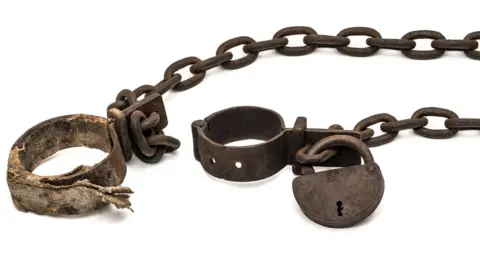Slavery: Welsh weavers 'implicated in US slave trade'
 Getty Images
Getty ImagesThe profits of slavery contributed to the expansion of towns and cities and fuelled the industrial revolution.
However new research by the University of South Wales has shown the extent of the links between rural mid Wales and the slave trade.
Prof Chris Evans has investigated the overlooked role Montgomeryshire and Merionethshire weavers played in producing clothes for slaves in the Caribbean and British North America.
At the height of the industry, Welsh cottage weavers were exporting almost eight-million yards of woollen cloth a year.
During the 16th and 17th Centuries, mid Wales had exported coarse woollen fabric known as "Welsh Plains" for clothing worn by people throughout western Europe.
However, by the start of the 18th Century, the availability of better quality machine-woven cloth meant that the market for it had shrunk.
Instead the weavers turned to the slave market. In the language of the time, now seen as highly offensive, Welsh Plains fabric became widely known as "Negro Cloth".
 Getty Images
Getty ImagesProf Evans explained it underwent an "astonishing expansion across the 18th Century".
"Between the Glorious Revolution of 1688 and the War of 1812, the enslaved population of the British sugar islands underwent a more than eight-fold increase, from 87,000 to 743,000; the rate of growth in British North America was even greater, from about 10,000 to 1.19 million."
He added: "Each of these slaves required a new set of clothes every year as it was presumed that their labour would reduce their outfits to rags within months.
"Heavy woollen cloth might not seem like an ideal choice for Caribbean conditions, but firstly, the slaves had no choice in the matter, and secondly Welsh Plains were incredibly durable, and doubled up as bedding during the occasional cold nights."
Prof Evans discovered plantation records indicating that five yards of Welsh Plains were allocated per slave per year; four yards for children.
Assuming that this was a typical amount, he calculates that Welsh weavers exported 7,736,000 yards in 1812, the peak year of the trade.
Unlike the vast mills of the industrial north of England - which would eventually put the Welsh weavers out of business - the mid Wales trade relied on individuals weaving on looms in their homes.
Evidence for the scale of the industry can be found in an estimated leap in population in the region of about 20% between 1780 and 1801.
Traditionally, the weavers had travelled with their cloth for sale to the Drapers Company of Shrewsbury, but as the industry expanded significantly, increasingly merchants from the slave ports of Bristol and Liverpool would travel directly to the cottagers, offering them cash advances to expand and speed up production.
Whilst the cash advances would no doubt have been welcome, Prof Evans argued that, even so, the mid Wales weavers were not leading lavish lifestyles.
'Time the memory was restored'
"We're not talking about the vast enrichment gained by slave owners and speculators; rather than saying the weavers were complicit in the slave trade, I think it would be fairer to say they were implicated in it, as you could argue they themselves were being exploited," he added.
A variety of factors combined to bring about the end of the trade in Welsh Plains, including the abolition of slavery which began in Caribbean in the 1830s, competition from mechanised mills, and war with both America and France.
By the end of the 1830s, production of the fabric had ceased altogether.
"By the time of Queen Victoria's accession, the woollen-producing districts which had girdled mid Wales recorded some of the highest levels of pauperism in Britain," Prof Evans added.
"Looms were abandoned, the people left, and the memory of the cloth left with them.
"It is time it was restored."
